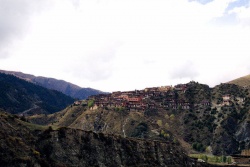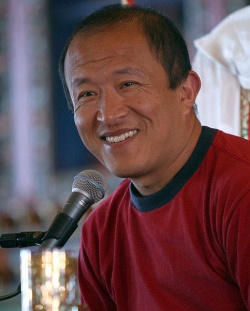Difference between revisions of "Dzongsar Monastery"
m (Text replacement - "Lha" to "Lha") |
|||
| Line 1: | Line 1: | ||
| − | '''Dzongsar [[Monastery]]''' | + | [[Image:Dzongsar and village.jpg|thumb|Dzongsar and village. ''Photo by Matthew Pistono'']] |
| + | [[Image:Dzongsar.jpg|thumb|Dzongsar Monastery. ''Photo courtesy of Stefan Eckel'']] | ||
| + | '''[[Dzongsar Monastery]]''' ([[Wyl.]] ''[[rdzong gsar dgon pa]]'') — a [[Sakya]] [[monastery]] in [[Derge]] which was the main seat of [[Jamyang Khyentse Wangpo]] and [[Jamyang Khyentse Chökyi Lodrö]]. The other main [[incarnations]] at [[Dzongsar]] were the Gongna and [[Ngari]] [[tulku]]s. | ||
| − | The [[Monastery]] belongs to the [[Sakya]] sect of [[Tibetan Buddhism]] and was the main seat of [[Jamyang Khyentse Wangpo]] and Jamyang Khyentse Chökyi Lodrö. However it is noted for its eclecticism of the [[Rimé movement]] and its openness to most of the teaching sects of [[Tibetan Buddhism]]. | + | ==History== |
| + | '''[[Dzongsar Tibetan Buddhist Monastery]]''' was founded by [[Chögyal Pakpa]] on his return from [[China]] in 1275. Before this it had been a [[Nyingmapa]] and a [[Kadampa]] [[temple]], and originally was the site of a [[Bön]]po [[shrine]]. Before 1958, [[Dzongsar]] had between 300 and 500 [[monks]], but the whole surrounding area would be filled with tents whenever [[Jamyang Khyentse Wangpo]] or [[Jamyang Khyentse Chökyi Lodrö]] were in residence, with [[people]] camping for days or even weeks in the {{Wiki|hope}} of gaining an audience with these great [[masters]]. All the [[temples]] were destroyed in 1958, but rebuilding began in 1983 under the guidance of Dr. [[Lodrö Puntsok]]. | ||
| + | |||
| + | ==Further Reading== | ||
| + | ===In [[Tibetan]]=== | ||
| + | *[[Dilgo Khyentse Rinpoche]], ''[[rdzong gsar dgon pa'i lo rgyus]]'', Collected Works, vol., 4 pp. 369-372 | ||
| + | |||
| + | ==See Also== | ||
| + | *[[Dzongsar Shedra]] | ||
| + | *[[Dzongsar Tibetan Hospital]] | ||
| + | *[[Dzongsar Khyentse Rinpoche]] | ||
| + | *[[The Joyful Grove of Immortal Accomplishment]] | ||
| + | |||
| + | ==External Links== | ||
| + | *[http://info.tibet.cn/en/newfeature/dzongsar/text/t20050613_36405.htm The Lineage of Tulkus at Dzongsar] | ||
| + | |||
| + | {{RigpaWiki}} | ||
| + | {{NewSourceBreak}} | ||
| + | |||
| + | '''[[Dzongsar Monastery]]''' is a [[Buddhist]] [[Monastery]] in [[Dêgê County]] in the {{Wiki|Garzê Tibetan Autonomous Prefecture}} of {{Wiki|Sichuan}}, [[China]], [[southeast]] of the town of [[Derge]] and [[east]] of [[Palpung]] [[Monastery]]. Historically it lay in the [[Kham]] region of [[Tibet]]. Founded in 746 and destroyed in 1958, it was rebuilt in 1983. | ||
| + | |||
| + | The [[Monastery]] belongs to the [[Sakya]] sect of [[Tibetan Buddhism]] and was the main seat of [[Jamyang Khyentse Wangpo]] and [[Jamyang Khyentse Chökyi Lodrö]]. However it is noted for its eclecticism of the [[Rimé movement]] and its [[openness]] to most of the [[teaching]] sects of [[Tibetan Buddhism]]. | ||
==History== | ==History== | ||
==== Old [[Monastery]] ==== | ==== Old [[Monastery]] ==== | ||
| − | Dzongsar Gonpa was originally founded in 746 AD by a [[Bönpo]] [[Lama]]. Originally there was just a very small temple at this site, called Jowo-Lha-Chig-Kar-Chig and the [[Bönpo]] shrine remained until 1958. The original [[Bönpo]] Gonpa was later transformed into a [[Nyingma]] and a [[Kadampa]] temple at some stage but it wasn't until 1275 that it was founded as a [[Sakya Monastery]] by [[Drogön Chögyal Phagpa]] on his return from [[China]]. | + | [[Dzongsar]] Gonpa was originally founded in 746 AD by a [[Bönpo]] [[Lama]]. Originally there was just a very small [[temple]] at this site, called Jowo-Lha-Chig-Kar-Chig and the [[Bönpo]] [[shrine]] remained until 1958. The original [[Bönpo]] Gonpa was later [[transformed]] into a [[Nyingma]] and a [[Kadampa]] [[temple]] at some stage but it wasn't until 1275 that it was founded as a [[Sakya Monastery]] by [[Drogön Chögyal Phagpa]] on his return from [[China]]. |
[[File:800px-Dzongsar_Monastery_01.jpg|thumb|250px|]] | [[File:800px-Dzongsar_Monastery_01.jpg|thumb|250px|]] | ||
| − | ::Before 1958, Dzongsar had between 300 and 500 permanent resident [[Monks]], but frequently contained many more people who camped around the [[Monastery]] in tents to meet with the lamas. All the temples were destroyed in 1958, but rebuilding began in 1983 under the guidance of Dr. Lodrö Puntsok. | + | ::Before 1958, [[Dzongsar]] had between 300 and 500 [[permanent]] resident [[Monks]], but frequently contained many more [[people]] who camped around the [[Monastery]] in tents to meet with the [[lamas]]. All the [[temples]] were destroyed in 1958, but rebuilding began in 1983 under the guidance of Dr. Lodrö Puntsok. |
| − | The [[Monastery]] had twenty three temples, large and small, and many important sacred rooms. It contained hermitages such as Khamshe Shekdra, Karmo Taktsang [[Retreat]] centre, Gargu Shangchub Rihtrek [[Retreat]] centre, Zamnang Pema Shelpuk, Zingkhok Trawo [[Retreat]] centre, Tsedrak Drulphuk, Gyalgen Chungtak, Munong Dorjee Drakal, Tsa-chu-juk Chenresig Lhakang, Honda Thongthong Gyalpo, and others. Dzongsar had a unique collection of Rimé scriptures and teachings, gathered by the proponents of the [[Rime]] movement, [[Jamgon Kongtrul]], Chokyi Lingpa and Khyentse Wangpo. Although Dzongsar was a [[Sakya Monastery]] by principle it was known to be flexible in its teachings and made it possible to study eight sects of [[Buddhism]]. | + | The [[Monastery]] had twenty three [[temples]], large and small, and many important [[sacred]] rooms. It contained hermitages such as Khamshe Shekdra, [[Karmo Taktsang]] [[Retreat]] centre, Gargu Shangchub Rihtrek [[Retreat]] centre, Zamnang [[Pema Shelpuk]], Zingkhok Trawo [[Retreat]] centre, Tsedrak Drulphuk, Gyalgen Chungtak, Munong Dorjee Drakal, Tsa-chu-juk [[Chenresig]] Lhakang, Honda Thongthong [[Gyalpo]], and others. [[Dzongsar]] had a unique collection of [[Rimé]] [[scriptures]] and teachings, [[gathered]] by the proponents of the [[Rime]] {{Wiki|movement}}, [[Jamgon Kongtrul]], Chokyi Lingpa and [[Khyentse Wangpo]]. Although [[Dzongsar]] was a [[Sakya Monastery]] by [[principle]] it was known to be flexible in its teachings and made it possible to study eight sects of [[Buddhism]]. |
[[File:483px-Dzongsar_Jamyang_Khyentse_Rinpoche.jpg|thumb|250px|]] | [[File:483px-Dzongsar_Jamyang_Khyentse_Rinpoche.jpg|thumb|250px|]] | ||
==== New [[Monastery]] ==== | ==== New [[Monastery]] ==== | ||
| − | In 1983 the temples and institutions of the [[Monastery]] were rebuilt but not in its full glory. It now only has six large and small temples. However, one hundred and eighty [[Monk]]'s residences have been rebuilt and today the main temples cover 48,200 square meters. Today there are more than 200 [[Monks]] residing at Dzongsar. Dzongsar also runs a school teaching Tibetan traditions, and has an enrollment of about 60 children. The [[Monastery]] is also known for its [[Incense]] and sells it commercially as Dzongsar Tibetan [[Incense]] Powder and Dzongsar Tibetan [[Incense]] Sticks. The [[Incense]] is made from precious, natural herbal materials from the highlands of Eastern [[Tibet]] and is said to have [[Healing]] effects for the [[Mind]] and soul, and have the ability to prevent infectious diseases. | + | In 1983 the [[temples]] and {{Wiki|institutions}} of the [[Monastery]] were rebuilt but not in its full glory. It now only has six large and small [[temples]]. However, one hundred and eighty [[Monk]]'s residences have been rebuilt and today the main [[temples]] cover 48,200 square meters. Today there are more than 200 [[Monks]] residing at [[Dzongsar]]. [[Dzongsar]] also runs a school [[teaching]] [[Tibetan]] [[traditions]], and has an enrollment of about 60 children. The [[Monastery]] is also known for its [[Incense]] and sells it commercially as [[Dzongsar]] [[Tibetan]] [[Incense]] Powder and [[Dzongsar]] [[Tibetan]] [[Incense]] Sticks. The [[Incense]] is made from [[precious]], natural herbal materials from the highlands of Eastern [[Tibet]] and is said to have [[Healing]] effects for the [[Mind]] and [[soul]], and have the ability to prevent infectious {{Wiki|diseases}}. |
| − | The current head [[Lama]] of Dzongsar is the Bhutanese [[Dzongsar Jamyang Khyentse Rinpoche]] who was also brought up at the [[Monastery]]. | + | The current head [[Lama]] of [[Dzongsar]] is the {{Wiki|Bhutanese}} [[Dzongsar Jamyang Khyentse Rinpoche]] who was also brought up at the [[Monastery]]. |
[[File:New_building_at_Dzongsar_April_2010.jpg|thumb|250px|New building next to the Shedra, April 2010.]] | [[File:New_building_at_Dzongsar_April_2010.jpg|thumb|250px|New building next to the Shedra, April 2010.]] | ||
{{W}} | {{W}} | ||
| + | |||
[[Category:Sakya monasteries]] | [[Category:Sakya monasteries]] | ||
[[Category:Buddhist monasteries in Sichuan]] | [[Category:Buddhist monasteries in Sichuan]] | ||
| + | [[Category:Dzongsar]] | ||
Revision as of 18:58, 2 February 2014
Dzongsar Monastery (Wyl. rdzong gsar dgon pa) — a Sakya monastery in Derge which was the main seat of Jamyang Khyentse Wangpo and Jamyang Khyentse Chökyi Lodrö. The other main incarnations at Dzongsar were the Gongna and Ngari tulkus.
History
Dzongsar Tibetan Buddhist Monastery was founded by Chögyal Pakpa on his return from China in 1275. Before this it had been a Nyingmapa and a Kadampa temple, and originally was the site of a Bönpo shrine. Before 1958, Dzongsar had between 300 and 500 monks, but the whole surrounding area would be filled with tents whenever Jamyang Khyentse Wangpo or Jamyang Khyentse Chökyi Lodrö were in residence, with people camping for days or even weeks in the hope of gaining an audience with these great masters. All the temples were destroyed in 1958, but rebuilding began in 1983 under the guidance of Dr. Lodrö Puntsok.
Further Reading
In Tibetan
- Dilgo Khyentse Rinpoche, rdzong gsar dgon pa'i lo rgyus, Collected Works, vol., 4 pp. 369-372
See Also
- Dzongsar Shedra
- Dzongsar Tibetan Hospital
- Dzongsar Khyentse Rinpoche
- The Joyful Grove of Immortal Accomplishment
External Links
Source
Dzongsar Monastery is a Buddhist Monastery in Dêgê County in the Garzê Tibetan Autonomous Prefecture of Sichuan, China, southeast of the town of Derge and east of Palpung Monastery. Historically it lay in the Kham region of Tibet. Founded in 746 and destroyed in 1958, it was rebuilt in 1983.
The Monastery belongs to the Sakya sect of Tibetan Buddhism and was the main seat of Jamyang Khyentse Wangpo and Jamyang Khyentse Chökyi Lodrö. However it is noted for its eclecticism of the Rimé movement and its openness to most of the teaching sects of Tibetan Buddhism.
History
Old Monastery
Dzongsar Gonpa was originally founded in 746 AD by a Bönpo Lama. Originally there was just a very small temple at this site, called Jowo-Lha-Chig-Kar-Chig and the Bönpo shrine remained until 1958. The original Bönpo Gonpa was later transformed into a Nyingma and a Kadampa temple at some stage but it wasn't until 1275 that it was founded as a Sakya Monastery by Drogön Chögyal Phagpa on his return from China.
The Monastery had twenty three temples, large and small, and many important sacred rooms. It contained hermitages such as Khamshe Shekdra, Karmo Taktsang Retreat centre, Gargu Shangchub Rihtrek Retreat centre, Zamnang Pema Shelpuk, Zingkhok Trawo Retreat centre, Tsedrak Drulphuk, Gyalgen Chungtak, Munong Dorjee Drakal, Tsa-chu-juk Chenresig Lhakang, Honda Thongthong Gyalpo, and others. Dzongsar had a unique collection of Rimé scriptures and teachings, gathered by the proponents of the Rime movement, Jamgon Kongtrul, Chokyi Lingpa and Khyentse Wangpo. Although Dzongsar was a Sakya Monastery by principle it was known to be flexible in its teachings and made it possible to study eight sects of Buddhism.
New Monastery
In 1983 the temples and institutions of the Monastery were rebuilt but not in its full glory. It now only has six large and small temples. However, one hundred and eighty Monk's residences have been rebuilt and today the main temples cover 48,200 square meters. Today there are more than 200 Monks residing at Dzongsar. Dzongsar also runs a school teaching Tibetan traditions, and has an enrollment of about 60 children. The Monastery is also known for its Incense and sells it commercially as Dzongsar Tibetan Incense Powder and Dzongsar Tibetan Incense Sticks. The Incense is made from precious, natural herbal materials from the highlands of Eastern Tibet and is said to have Healing effects for the Mind and soul, and have the ability to prevent infectious diseases.
The current head Lama of Dzongsar is the Bhutanese Dzongsar Jamyang Khyentse Rinpoche who was also brought up at the Monastery.




